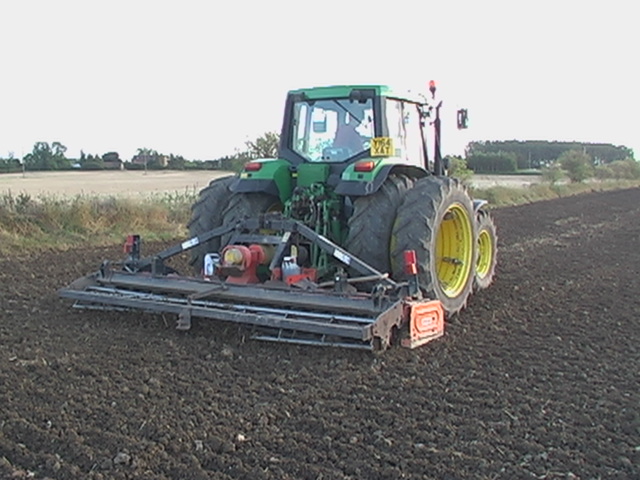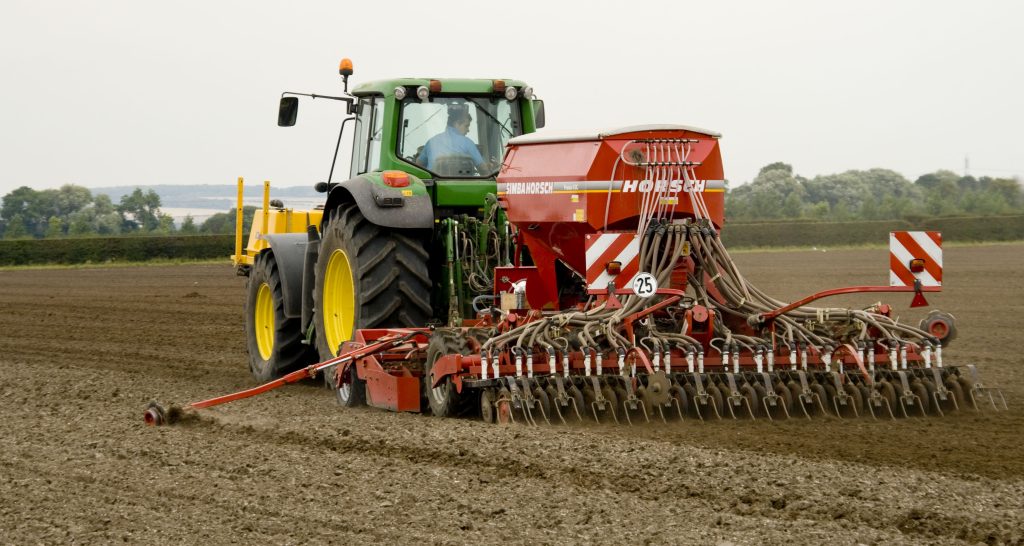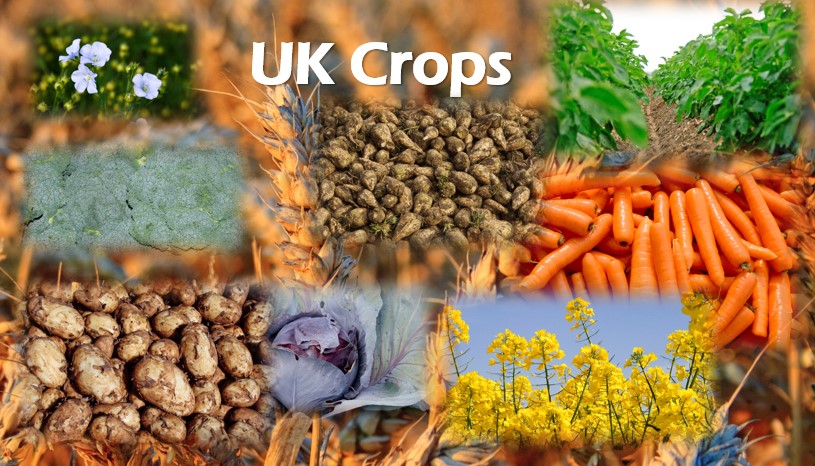Quick agronomy facts:
| Oilseed Rape | ||
| Seed Rate kg/Ha | 3 – 6 | |
| Nitrogen (N) kg/Ha | up to 210 | |
| Phosphate (P) kg/Ha | 50 | |
| Potash (K) kg/Ha | 40 | |
| Av . Yield t/Ha | 3.7 |
Other Key Points
Typical Protein & Oil Contents
| Oilseed Rape – harvested Protein Oil | 38% 45% |
| Oilseed Meal = (after crushed for oil) Oil Protein | 6-36% 28 – 45% |
Storage
| Recommended Moisture Content for long term storage | 8% m.c. at 100C |
Typical Weeds, Pests, Diseases
| Weeds | thistles, cleavers, mayweed, and poppies |
| Pests | Slugs, Aphids, Pollen Beetle, Flea Beetle, Pigeons |
| Diseases: | Light leaf spot, Sclerotinia, Phoma, Alternaria. Club root |
Cultivating Success: An Apprentice’s Guide to Crop Husbandry
Crop husbandry might sound grand, but it simply means growing and harvesting crops with good management. In practice, it’s all about giving plants the best conditions to grow – from ploughing to planting to harvesting – while keeping the soil healthy. Done well, it feeds people and animals today and preserves the land for tomorrow. (As one old handbook puts it: the goal is “to produce good crops as economically as possible without impoverishing the land”. In short, think of the field as both a farm and a classroom – you’re the teacher setting it up, and Nature’s the student learning to grow.
Seedbed Preparation

A tractor pulls a disc cultivator across a field – preparing a cosy seedbed for planting.
Your seedbed is basically a bed for baby plants. Aim for a fine, crumbly soil (“fluffy” but not powdery) so young roots can push through easily. Avoid leaving huge clods or stony lumps under the seeds – think of those as boulders under the sheets. On the other hand, don’t till the soil to dust; a bit of natural aggregate helps hold moisture. In practice, experts advise: “Avoid overly cloddy seedbeds but maintain some structure” ahdb.org.uk. Once the seeds are in, do a gentle roll or pack: this “tucks” them in, sealing in moisture and good contact with soil. (A bit like turning down the quilt so nothing blows away!)
- Residue Management: Chop and spread old crop residue evenly before sowing, or use a harrow. Stray straw can jam drills or block seed placement canolacouncil.org. A smooth, even surface means drills place seed at the right depth (usually 1–2.5 cm for most crops ) and cover it properly.
- Packing: Once sowing, a row-coulter or packer wheel lightly firms soil over the seed. This improves seed-to-soil contact and reduces moisture loss. In short, pack just enough to “seal” the seedbed – imagine tucking seeds under the covers so they stay warm and damp.
Key points: Work the soil evenly (a couple of passes of plough, cultivator or disc), break up any large lumps, level out high spots, and finish with a light roll if needed. A well-prepared seedbed is like a mattress for seeds – cozy, snug, and ready for growth.
Seed Rates and Planting Depth

Getting the seed rate right is part math, part experience. A useful trick is to think in terms of plants per square meter, not just kilograms per hectare. For example, UK winter-wheat growers often aim for ~240 plants/m² by spring fwi.co.uk. To achieve that, you must drill more seeds (maybe 300–400 seeds/m²) because not every grain sprouts and some plants die over winter. Consider these factors:
- Target stand: Decide how many plants you want (e.g. 240/m² wheat, or 25–35/m² oilseed rape). Then work backwards using the seed’s thousand-grain weight (TSW) and expected losses.
- Germination & losses: A rule of thumb is that ~4–10% of seeds fail to germinate and maybe ~30–40% of established plants die in winter for cereals. fwi.co.uk. Light sandy soils or excellent seedbeds might see only ~23% loss, but heavy soils or patchy fields can exceed 40%. (In other words: a standard rate from a book might leave you short if you don’t account for your field’s quirks.)
- Adjust for conditions: Late sowing, cool soils, slugs or clods call for higher rates. For instance, one guideline suggests adding 10% more seed for slug risk and another 10% for a cloddy seedbed fwi.co.uk. (So if your base rate is 190 kg/ha, that becomes 228 kg/ha once you tack on 20% – going from ~352 to ~438 seeds/m² .) As agronomists say, “Drilling by weight is pure guesswork” unless you do these calculations.
Depth matters too. A general rule of thumb: sow most cereal grains about 3–5 cm deep kws.com (wheat often 2–4 cm. If you’re too deep, seedlings spend precious energy tunnelling up; too shallow, and seeds might dry out or be lost. Oilseeds like rape are smaller seeds, so only 1–2 cm down is best. Sugar beet seeds (pelleted) usually go 2–4 cm deep, while tiny grass or clover seeds sit very near the surface (<1–2 cm). Potatoes: Plant the tuber so its “eyes” (sprouts) end up at about soil level – you’ll ridge them up later potatoworld.eu.
In practice, use seed-rate tables or online calculators as starting points (AHDB has a handy converter). But always tweak them: standard rates are guidelines. Soil type, weather and variety vary, so on your farm you might go higher or lower. Keep records and test small patches if unsure.
Sowing Key Crops

Every crop has its quirks. Here are some practical pointers for our main crops:
- Cereals (wheat, barley, oats): These thrive in a firm, well-tilled seedbed. Plant winter cereals in autumn (Sept–Nov) or spring cereals as soon as soil warms. Drill seeds roughly 3–5 cm deep. kws.com Because wheat and barley can tiller (make extra shoots), small gaps aren’t fatal – but uneven stands mean weeds can creep in. Aim for an even distribution: even on clay fields, targets around 220–260/m² in early autumn, rising to 300–420/m² if sowing slips into October. kws.com Remember that sandy soils may give ~90% germination while heavy loams only ~65%, so adjust your seed rate. Keep in mind too that very high plant counts can cause lodging (tall, floppy crops), so balance seed rate with fertility and height.
- Oilseeds (oilseed rape, etc.): Usually planted in late summer (mid-Aug to Sept). Soils should be moist and warm for quick root growth. Small rape seeds get ~1.5–2 cm of cover, packed firm. fwi.co.uk. Aim for about 25–35 mature plants/m² – which often means drilling roughly 50–120 seeds/m² depending on variety. Hybrid varieties need fewer seeds than conventional hybrids. Watch pests: broad flea beetles love young rape, so some farms now drill earlier (late July) or very late (after mid-Sept) to dodge the worst of them. Good weed control also helps (e.g. keeping weeds shallow with minimal tillage). Overall, firm seed-to-soil contact is critical for these tiny seeds – under-pressure rollers or tampers help ensure moisture uptake.
- Sugar Beet: A classic spring drill. Sow pelleted seed in April/May after frost risk is past. Plant in rows (typically 45 cm apart) about 2–4 cm deep. Fields should be well-tilled and level; you want even emergence for later mechanical thinning. Target about 100,000 plants per hectare (10 plants/m²). bbro.co.uk. If the seedbed is cloddy or you had poor emergence earlier, increase your seed rate in those spots. Always ensure good moisture – sugar beet seedlings need warm, damp soil to get going. Remember, every lost beet is hard to replace, so it pays to be thorough.
- Potatoes: These are planted tubers, not tiny seeds. Use a planter or dig a trench and drop seed potatoes (or pieces) so the eyes face upward. The top of each tuber should end up roughly at soil level. potatoworld.eu. If the variety is sensitive to light (greening) or the soil cracks, you may plant a bit deeper. Plant in rows about 75–90 cm apart; in the UK 90 cm is common. Within the row, leave roughly 25–30 cm between plants – that’s around 3–4 potatoes per m². After emergence, you’ll hill soil up around the stems. Well-prepared loose soil and consistent moisture make for even stands.
- Forage Crops (grasses & clovers): Often sown in autumn or spring on a fine crumb seedbed. Broadcast or drill grass/clover seed shallow – about 1–2 cm deep (and <1 cm for very small clover seed). ahdb.org.uk. Because many seedlings die (only ~15–25% survive the first year), farmers traditionally use high seed rates (e.g. 18–35 kg/ha of a grass-legume mix) as insurance. Studies even show that very high rates just compensate for losses, so you’ll often see those old “belt-and-braces” numbers. If drilling, choose low seedbed disturbance drills; if broadcasting, do it into moisture and lightly rake. Rolling is recommended: firming the soil immediately after sowing helps prevent wind or rain from moving seeds and helps pests (like blackgrass) from finding loose spots.
In summary, match each crop to its needs. Cereals tolerate deeper sowing and can tiller; oilseed rape needs a gentle start; root crops and potatoes require uniform emergence. And in all cases, good soil contact and moisture are key to germination and emergence.
Safety Tips: Tractors, Soil & You
Farming is fun, but it can be risky. Keep these safety and soil-care guidelines in mind:
- Tractor & Machinery Safety: Keep PTO shafts fully guarded and avoid loose clothing near them. hseni.gov.uk. When clearing blockages or adjusting equipment, stop the tractor, set the brake, and turn off the engine first. Only climb on/off when the machine is off, and make sure anybody driving heavy gear (like telehandlers or quads) has proper training. Simply put: a few seconds of caution can prevent a lifetime of injury.
- Soil Protection: Avoid compaction! Don’t drag heavy machinery over fields that are wet or soft (especially clays and silts). defrafarming.blog.gov.uk. Compacted soil chokes roots and turns rain into runoff. Instead, wait for dry conditions, use wide tires or tracks at low pressure, and keep traffic to designated tramlines. Use cover crops, grass buffers or leftover stubble to protect bare soil – these act like a sponge during storms. fwi.co.uk. In other words, “well-structured soil is central to the solution” of erosion. Adding organic matter (crop residues, manure or compost) also strengthens soil structure and reduces surface crusting. fwi.co.uk defrafarming.blog.gov.uk.
- Erosion Watch: If you farm slopes, go across the hill rather than straight up and down when ploughing or drilling. Wherever possible keep vegetation or dead mulch on vulnerable slopes. The Game & Wildlife Trust notes that crops harvested late (like potatoes or maize) or late-sown cereals tend to exacerbate erosion problems. fwi.co.uk. So plan field layout to break water flow (e.g. grass strips), and fix drainage issues. Think of your fields as part of a catchment – a little soil saved means a lot of mud not washing onto roads or streams.
Safety and soil care go hand-in-hand: a smart, careful approach on the tractor (belt on, guards down, engine off before hands on) not only keeps you alive but also helps keep the farm’s soil — our shared home — intact. defrafarming.blog.gov.uk fwi.co.uk.
Key Takeaways
- Prepare the bed: A good seedbed is the foundation. Aim for fine tilth (no big clods) and firm seed-soil contact. Roll or pack lightly after sowing to seal in moisture.
- Calibrate your rates: Use seed-rate tables or calculators as a starting point, but always adjust for your conditions. Target a plant/m² stand (e.g. ~240 wheat plants/m².) and work backward using seed weight and losses. Remember: “standard” kg/ha rates are only a rough guide.
- Match crop to conditions: Each crop has its preferences. For example, winter wheat can handle deeper sowing (3–4 cm) and compensates by tillering, while tiny grass or clover seeds must be very shallow. Check guidelines for each crop’s ideal timing, depth and spacing, and use those as your checklist.
- Safety & soil: Keep guards on (PTO shafts, etc.) Never assume a machine is harmless – stop it completely before any maintenance. Protect your soil: don’t drive on wet, puddly fields, and leave cover (stubbles, cover crops) on slopes. A healthy soil (lots of organic matter) acts like a sponge for rain.
- Hands-on practice: Reading is great, but farming is a craft. After the theories and these bullet points, hop on the tractor, dial in a seed drill and give it a try. Watch what happens, ask your mentor or agronomist, and yes – don’t be afraid to laugh if things go a bit sideways! (A good farmer joke might just be the best medicine after a long day.) In the field, you learn things no lecture can teach.
By blending these tips with some elbow grease and curiosity, you’ll see the difference in the next crop. Crop husbandry is equal parts science and art – once you get the hang of it, you’ll be growing crops (and wisdom) like a pro. Happy farming, and may your harvests be bountiful (and your tractor rides smooth)!
Key actions: Prepare a firm seedbed; calibrate seeding rate (using seed count, TSW and expected loss) for each field; plant each crop at its ideal depth/spacings; always use machine safety gear; protect bare soil from compaction and erosion. And of course, get out there and practice – nothing beats real-world experience on the farm.
Below is presentation which gives more details about Oilseeds grown in the UK.
